
Day 5 and 6
Today is a Salone day with the last two workshops. Before the Salone I walked westwards from the Hotel along the Vittorio Emanuele II to the river Po. This is a wide road with a central tree covered island along its length. It does not have the covered footpaths of the via Roma but it still has grand buildings housing shops and banks. As I walked along a caught a glimpse of the Mole up one of the side streets. The Po is nearly as wide as the Thames in London quite slow flowing and majestic. Odd glimpses that I have had of the smaller rivers in the city indicated that the tributaries are much faster flowing. There were two men sculling down the middle of the river gondolier fashion but whilst the boat had an upturned prow it was a shorter and wider vessel than a gondolier. Coming back up the road there is a small park before returning to the lines of ornate buildings along the roadside.
When I got to the Porta Nuova station I sought out the bus company counter and asked the man for a mappa. Hey presto I had a 'must have' bus map. On to the bus and off to the Salone. I was a bit early so I stopped at a local cafe for a cuppuchino – 1.1 euros 80p.
When the Salone opened I started touring the last corner which I had not seen. Again there was a fair mixture of stalls displaying all the wares of the world. Oysters to toffee and beef to bunnies it was all there.
1300
Distinctive Names Distinctive Forms
A tasting of 6 distinctive cheeses that you cannot normally buy.
The wines presented were, 'Assolo Regiano', 'Concerto Regiano', 'Icari Sura de Mur' and 'Icari Casscina de Brute'. The last two Icari wines were exceptionally good.
At the top table there appeared to be a Chairman, a Wine Buff and 4 Cheese makers.
The first tasting was a 'Raviggiolo' which dates from 1500. The producer is a Roberto Boscarini who is from the Rome area and he uses the milk from his herd of 23 head of a local breed of cattle supported by the production from 6 cows owned by a neighbour. The milk is processed within 2 hours of milking and is sold the next day. The shelf life is about four days.
The cheese tastes like a mild form of crowdie a delicate creamy taste that would make a very good aperitif.
The second tasting was a 'Sarass del Fen' a ricotta cheese which is matured whilst wrapped in hay. The hay can be smelt on the outside of the cheese and it has a soft gentle flavour.
The third cheese was a 'Pannerone di Lodi'. This is a very holy(many holes) cheese. After the curds are broken the cheese is formed but some of the whey is left between the curd particles to give a slightly bitter taste. The sample that we had was a bit over the top and it tasted as though the residues had gone into secondary fermentation.
The fourth cheese was an 'Abbruzzi Marzolina' – The Cheese of March. This was a goat's cheese made with kids rennet using a recipe kept by an elderly lady. The cheese is only made for one month per year. After it is made it is turned daily on wooden slats. When it is ready it is put into barrels of olive oil for storage. The cheese had a dry soft texture with a nice medium strong flavour. Before it is sold it is removed from the oil and dried.
The next cheese was 'Montobore' a Ligurian cheese. It was built like a cottage loaf with two or more levels and is consequently difficult to turn. It is a mixture of 30% sheep's milk and 70% cow's milk. Both animals are local breeds. It had a very pleasant taste with a slight tang and was 1 month old. It dries out if it is kept for long.
The last cheese was a 'Conciato Romano' referred to as the oldest cheese in Italy. The cheese is made from ewe's milk with kid's rennet. The cheese is put on a board to dry for two to three weeks and is then washed in water that has already been used to cook pasta. After this the cheese is plunged into amphoras that are filled with olive oil, pepper and thyme. The amphorae are sealed and kept for from 1 to 3 years. When the cheeses are removed for consumption the surplus oil is removed. The cheese had a very pleasant scent and an extremely good mild but distinctive flavour.
Please remember that this is compiled from notes taken from the translator it is more than probable that the names and certainly the spellings may not be entirely accurate. The workshop 'Distinctive Names, Distinctive Forms' was very enjoyable and very informative. It is unlikely that I will get the opportunity to taste some of these cheeses again.
By now the Salone Exhibition was heaving there were people shoulder to shoulder everywhere. Between the Exhibition Hall and the Workshops area there is a roadway with steps and concrete pillars to sit on so from time to time I enjoyed the watery sunlight in the fresh air.
The next and the last Workshop was 'Bagna Cauda and Praesidium Vegetables'.
The Bagna Cauda is a way of serving food, usually vegetables. The method dates from the Middle Ages and was possibly the way that the salt workers were fed. The Bagna Cauda is a bowl filled with a 'soup' of olive oil, anchovies and garlic. Into this soup you dip the selection of vegetables.
In order that we could bear to do this we were supplied with four different wines.
The first was a 'Scrimaglio', the second was a Brentura Barbera d'Asti', the third was a 'La Cimirara' and the fourth was a 'Le Polé Barbera d'Asti'. They were all quite pleasant wines but none of them was a real sparkler.
The vegetables served with the Bagna Cauda were three types of Turnip, two varieties of Sweet Pepper, Chicory, White Onions, Red Onions, Artichoke, Cabbage and Cardoons.
They were a special type of Cardoon which is grown using a strange technique. Before the Cardoons are ready and in order to blanch them the plants are dug up and replanted/buried at an angle of forty five degrees. This must demand an enormous amount of physical effort as the pictures showed it being done by hand in what looked like significant patches of land. The plant continues to grow and attempts to grow perpendicularly. The result of this is that the Cardoons that are harvested some 25 days later are hook shaped and blanched. From the taste point of view they are similar in texture to a large celery but do not have such an overpowering flavour as celery. There were several stalls within the Exhibition displaying various varieties of Turnip which were particular to small areas of country side. At each stall I asked whether they had any seed available but none of them would part with any. For the Bagna Cauda we had three different types of turnips each with its own particular nuance.
The actual 'soup' of the Bagna Cauda was not a totally neutral flavour but it did seem to go well with all of the vegetables. Obviously it was not served to us piping hot but it appears that at a Bagna Cauda Fest it may well be kept on a flame and shared by all. I felt that it was probable that the vegetables had been supplied on the opening day of the exhibition and they had lost some of their vivacity – but that is perhaps my view because my vegetables are consumed within hours of growing.
It was an interesting workshop and I did learn that it was very unwise to suggest to the 'Bagna Cauda Creator' that his recipe was a can of worms – he got awfully excited!
And that really was that. I went back into the Exhibition and had a random walk back through it noticing that many stalls had 'sold out' but even though the event only had a few hours to run there were still many people about. I have not really done justice to the magnitude and variety of the Exhibition there were many products from many countries. There were many Regional Stands extolling the virtues of their local tourist attractions, the Italian National Parks and Nature Reserves, the bird watching around the Po Estuary, Cycling holidays Skiing holidays – and the food!
I took a tram back into the city a number 15. This time I got off at the stop just around the corner – yippee I was much nearer the station. That evening I went for something to eat at a sort of franchise eatery called Brek, I had tried it before and found it very good. A plate of cold meat, salad, a bread roll and a cappuchino -7.70 euros £5.50 can't be bad.
The morning of Day 6 was set aside for sight seeing and I had decided to go to the Mole and to Supergra. So I paid the Hotel, left my bags in their care and set off.
The morning dawned dull and drizzly and it got steadily duller and drizzlier as I searched for the Mole from memory and the map.
I was surprised during my wanderings around Turin by the number of churches that appeared to be closed.

On my wanderings to the Mole I found what I think was the church of San Filippo Neri. It is a very grand building with breathtaking decorative architecture.
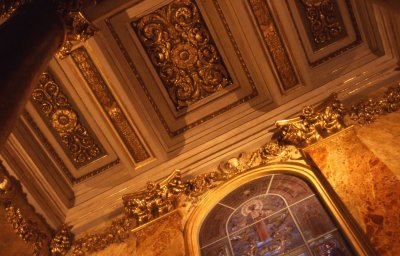
As you can see here the decorative mouldings in the ceiling must have given the plasterer a stiff neck for life!
Eventually I found The Mole and gaily entered. I was half way up the first set of stairs when a man came along and suggested that I should have paid!
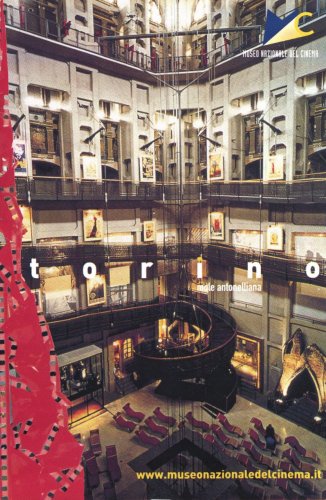
Here is a picture of the ticket. As you can see the building is a series of internal galleries through the middle of which you can see the tracery of the wires for the lift. I got there before the lift had started for the day so
I repaired to the snack bar for a cappuchino. When I sat down I found that the tables each had a number of screens set into their surface and these were showing films. You could even select the film which you would like to watch.
As you can see from the ticket there is a viewing area where presumably they show historic films and around the galleries there are various posters of past films.
The lift is run by the bus company and it whisks you up to the viewing gallery very smoothly.
The principle view from the gallery was mist and drizzle. You certainly could not see the Alps!
(There may be a note at the end setting out the history of the Mole.)
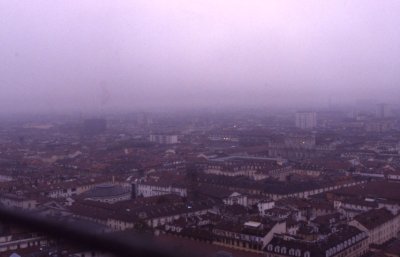
Here is the view from the gallery over a wet and miserable Turin. Many of the large buildings that you see here are Palace and Government buildings.

Here you can see the face of the Palazzo Madama which now houses the Royal Armoury, The Royal Library and The National Archive of Turin.
These were seen on foot during day three.
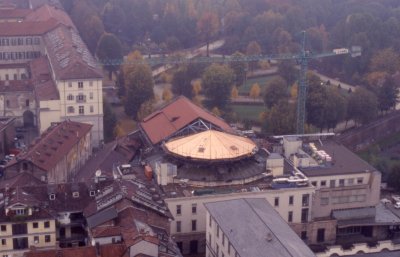
Now we are behind the Palazzo Madama from another side of the gallery. The building under construction in the foreground is using copper for the roof covering. I wondered whether it was a preference of the Italians to use copper where perhaps we would have used tiles or lead or felt or even plastics.
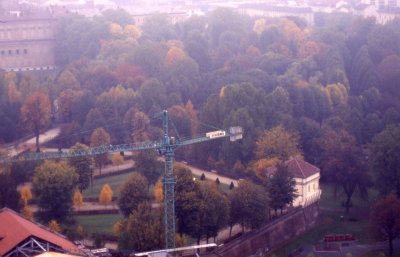
Here you are looking back at the scene from Day 3 where you could see the Mole from the Giardini di Palazzo Reale. This Palace appears to be attached to or part of the Palazzo Madama.
By consulting my shiny bus map I now found a bus that would carry me to the Superga. Many years ago there was a battle. King Vittorio Amedeo II climbed to the top of this hill to survey the strength of the opposing Franco Spanish army. Feeling in need of additional support he prayed to the Virgin Mary for help. He told the Virgin Mary that if she would help him to save Turin he would build a votive church to her on the hill where he was standing. As you will have guessed the Piedmontese were victorious and after the expenses of the war had been paid he spent the next fifteen years building The Basilica di Superga.
It may now be reached by funicular railway or bus a far cry from King Vittorio's time.
I caught a tram to the railway station where I could see some very picturesque trains but judging by the frenzied activity around a large tanker lorry at the entrance I realised that there would be little possibility of a ride on the train! So the bus – first gear all of the way up this steep and winding road past many modern day palazzos with security gates large cars and all of the trimmings. As we wound our way upwards we began to pass many stone 'grottos' that were the stations of the cross. They were similar to the grotto shown near the cheese factory on day two but were in a far worse state of repair. When we got to the top there was no sign of the church – just fog.
Eventually I found the building and it is enormous probably as big as St Paul's Cathedral.
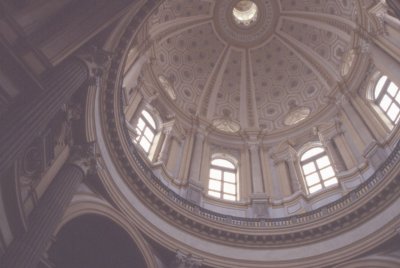
This is a view of the inside of the dome. Above me there was a man walking around and I suppose the surrounding rails/banisters are about 3ft high. Looking at it you can understand why it took fifteen years to build.
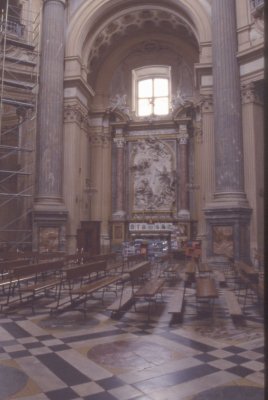
From floor to ceiling the finest materials and workmanship have been used.
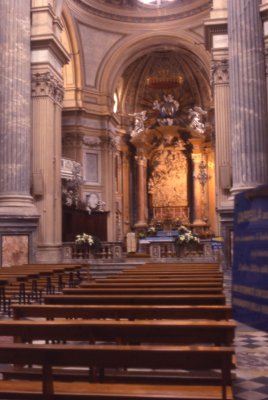
I am reluctant to use flash inside churches and in all probability this church is so large that flash would have been useless. All of the photographs were taken with quite long exposures and I am afraid that this one has a bit of camera shake.
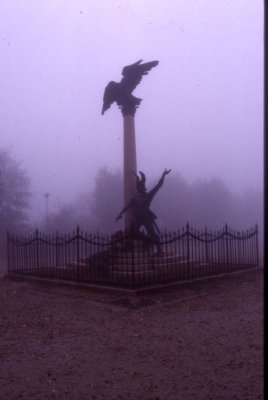 This
is where you get on and off the bus. I think that the monument
probably represents King Vittorio in a state of readiness to rout the
Franco Spanish Armies.
This
is where you get on and off the bus. I think that the monument
probably represents King Vittorio in a state of readiness to rout the
Franco Spanish Armies.
To return I had to use a new bus ticket I was told by the driver not to time stamp it until the bus was moving!
Once again my magic bus map put me on the right route back to the city centre. I wondered how the trams were controlled because quite often they would approach quite complex junctions where there was a choice of tram routes but the driver appeared to do nothing and the points were set to direct the tram along the correct road.
At one point on the way back my tram was steered into a passing loop so that another tram could pass us by yet the driver appeared to do nothing.
Back in the city centre I took some lunch in Brek's recovered my case from the Hotel and boarded the bus for the airport. On the bus I met two fellow members of the Aberdeenshire convivium, Callum and Val Buchanan and we made our way back to Aberdeen.
The flights were both on schedule and the inflight food was perhaps even horribler having had six well fed days. A very worthwhile and enjoyable holiday.
La Mole Antonelliana was originally built be the architect Alessandro Antonelli as a Synagogue between 1863 and 1869 when it was discontinued by the Jewish Community. Until it was reinforced after a tornado in 1953 it was the highest stone structure in Europe. There are apparently 1040 steps leading to the pinnacle from which it is said that you can see the Alps. The gallery to which I was carried in the lift is a mere 85m high.